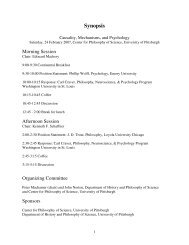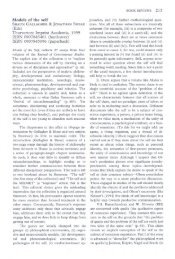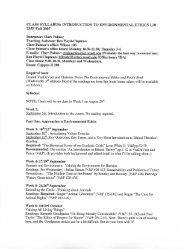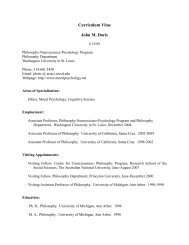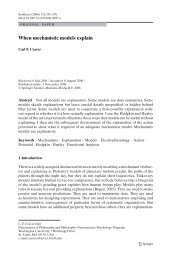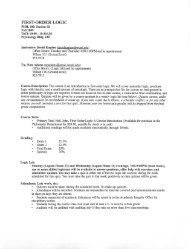The Blackwell Guide to the Philosophy of Science - The Department ...
The Blackwell Guide to the Philosophy of Science - The Department ...
The Blackwell Guide to the Philosophy of Science - The Department ...
Create successful ePaper yourself
Turn your PDF publications into a flip-book with our unique Google optimized e-Paper software.
Laura Ruetsche<br />
particle notions. Even granting that it is appropriate <strong>to</strong> run a particle interpretation<br />
<strong>of</strong> a quantization {âk, â †<br />
k}, one cannot run a sensible particle interpretation <strong>of</strong><br />
QFT unless one can privilege as physical a unitary equivalence class <strong>of</strong> representations<br />
admitting particle interpretations – as Saunders (1988) discusses, not all do.<br />
<strong>The</strong> default setting for a QFT is Minkowski space–time. And this furnishes a<br />
de fac<strong>to</strong> criterion <strong>of</strong> privilege: physical representations respect <strong>the</strong> symmetries <strong>of</strong><br />
<strong>the</strong> space–time, in <strong>the</strong> sense that <strong>the</strong>ir vacua are invariant under its full isometry<br />
group. Coupled with <strong>the</strong> requirement that physical representations admit only<br />
states <strong>of</strong> non-negative energy, this singles out a unitary equivalence class <strong>of</strong> representations.<br />
But this strategy for privilege breaks down in generic curved<br />
space–time settings, which do not supply <strong>the</strong> symmetries it requires. 14<br />
<strong>The</strong> algebraic approach <strong>to</strong> quantum <strong>the</strong>ories grounds an entirely different<br />
response <strong>to</strong> unitarily inequivalent representations. <strong>The</strong> algebraic approach articulates<br />
<strong>the</strong> physical content <strong>of</strong> a <strong>the</strong>ory in terms <strong>of</strong> an abstract algebra A. Observables<br />
are elements <strong>of</strong> A, and states are normed, positive linear functionals w: A<br />
Æ . <strong>The</strong> expectation value <strong>of</strong> an observable A Œ A in state w is simply w(A).<br />
Abstract algebras can be realized in concrete Hilbert spaces. A map p from elements<br />
<strong>of</strong> <strong>the</strong> algebra <strong>to</strong> <strong>the</strong> set <strong>of</strong> bounded linear opera<strong>to</strong>rs on a Hilbert space H<br />
furnishes a Hilbert space representation <strong>of</strong> <strong>the</strong> algebra. In particular, all Hilbert<br />
spaces carrying a representation <strong>of</strong> <strong>the</strong> Weyl relations are also representations <strong>of</strong><br />
<strong>the</strong> abstract Weyl algebra. For <strong>the</strong> algebraist, “[t]he important thing here is that<br />
<strong>the</strong> observables form some algebra, and not <strong>the</strong> representation Hilbert space<br />
on which <strong>the</strong>y act” (Segal, 1967, p. 128). Inequivalent representations need<br />
not puzzle him, for conceiving <strong>the</strong> state space <strong>of</strong> a quantum <strong>the</strong>ory as <strong>the</strong> space<br />
<strong>of</strong> algebraic states, he has rendered unitary equivalence an inappropriate criterion<br />
<strong>of</strong> physical equivalence. (Early proponents <strong>of</strong> <strong>the</strong> algebraic approach concocted<br />
baldly operationalist motivations for alternative glosses on physical equivalence;<br />
see Summers (1998) for a review.) Nor need he trouble with particles, for<br />
particle notions are (at least prima facie) <strong>the</strong> parochial residues <strong>of</strong> concrete<br />
representations.<br />
Standard quantum states are probability measures over closed subspaces <strong>of</strong><br />
Hilbert space. <strong>The</strong> class <strong>of</strong> algebraic states is broader than <strong>the</strong> class <strong>of</strong> such probability<br />
measures. <strong>The</strong>re are, for instance, algebraic states which can accomplish what no<br />
Hilbert space state can: <strong>the</strong> assignment <strong>of</strong> precise and punctal values <strong>to</strong> continuous<br />
observables (Clif<strong>to</strong>n, 1999). Some would advocate restricting admissable algebraic<br />
states. A restriction that looks down <strong>the</strong> road <strong>to</strong> quantum gravity is <strong>the</strong> Hadamard<br />
condition, which requires admissable state <strong>to</strong> be states for which a prescription<br />
assigning <strong>the</strong> stress-energy tensor an expectation value succeeds. (Provocatively, in<br />
closed space–times such states form a unitary equivalence class (Wald, 1994, §4.6).<br />
Both ma<strong>the</strong>matical and physical features <strong>of</strong> algebraic states merit, and are receiving,<br />
fur<strong>the</strong>r attention, attention which should inform discussion about <strong>the</strong> state space,<br />
and maybe even <strong>the</strong> on<strong>to</strong>logy, appropriate <strong>to</strong> QFT.<br />
220



